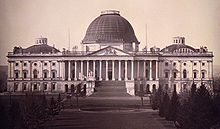32nd Congress
| 32nd United States Congress | |
|---|---|
|
31st ←
→ 33rd
|
|

United States Capitol (1846)
|
|
| March 4, 1851 – March 4, 1853 | |
| Senate President | Vacant |
| Senate Pres. pro tem |
William R. King (D) David R. Atchison (D) |
| House Speaker | Linn Boyd (D) |
| Members | 62 senators 233 representatives 4 non-voting delegates |
| Senate Majority | Democratic |
| House Majority | Democratic |
| Sessions | |
|
Special: March 4, 1851 – March 13, 1851 1st: December 1, 1851 – August 31, 1852 2nd: December 6, 1852 – March 4, 1853 |
|
The Thirty-second United States Congress was a meeting of the legislative branch of the United States federal government, consisting of the United States Senate and the United States House of Representatives. It met in Washington, D.C. from March 4, 1851, to March 4, 1853, during the third and fourth years of Millard Fillmore's presidency. The apportionment of seats in the House of Representatives was based on the Sixth Census of the United States in 1840. Both chambers had a Democratic majority.
This list is arranged by chamber, then by state. Senators are listed by class and Representatives by district.
Senators were elected by the state legislatures every two years, with one-third beginning new six-year terms with each Congress. Preceding the names in the list below are Senate class numbers, which indicate the cycle of their election. In this Congress, Class 1 meant their term began with this Congress, facing re-election in 1856; Class 2 meant their term ended with this Congress, facing re-election in 1852; and Class 3 meant their term began in the last Congress, facing re-election in 1854.
The names of members of the House of Representatives are preceded by their district numbers.
Both representatives were elected statewide on a general ticket.
The count below reflects changes from the beginning of the first session of this Congress.
Lists of committees and their party leaders.
...
Wikipedia
